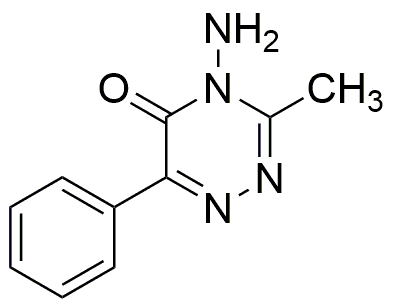Metamitron is widely utilized in research focused on:
- Agricultural Herbicide: It is primarily used as a selective herbicide in sugar beet cultivation, effectively controlling a range of broadleaf weeds while minimizing damage to the crop.
- Environmental Studies: Researchers employ Metamitron to study its environmental impact, particularly its degradation in soil and water, which helps in assessing its safety and sustainability in agricultural practices.
- Analytical Chemistry: It serves as a standard reference in analytical methods for detecting pesticide residues, aiding in ensuring food safety and compliance with regulations.
- Plant Physiology Research: Scientists use it to investigate plant responses to herbicides, contributing to the understanding of plant metabolism and resistance mechanisms.
- Formulation Development: The chemical is explored in developing new herbicide formulations that enhance efficacy and reduce environmental impact, addressing the growing demand for sustainable agricultural solutions.
General Information
Properties
Safety and Regulations
Applications
Metamitron is widely utilized in research focused on:
- Agricultural Herbicide: It is primarily used as a selective herbicide in sugar beet cultivation, effectively controlling a range of broadleaf weeds while minimizing damage to the crop.
- Environmental Studies: Researchers employ Metamitron to study its environmental impact, particularly its degradation in soil and water, which helps in assessing its safety and sustainability in agricultural practices.
- Analytical Chemistry: It serves as a standard reference in analytical methods for detecting pesticide residues, aiding in ensuring food safety and compliance with regulations.
- Plant Physiology Research: Scientists use it to investigate plant responses to herbicides, contributing to the understanding of plant metabolism and resistance mechanisms.
- Formulation Development: The chemical is explored in developing new herbicide formulations that enhance efficacy and reduce environmental impact, addressing the growing demand for sustainable agricultural solutions.
Documents
Safety Data Sheets (SDS)
The SDS provides comprehensive safety information on handling, storage, and disposal of the product.
Product Specification (PS)
The PS provides a comprehensive breakdown of the product’s properties, including chemical composition, physical state, purity, and storage requirements. It also details acceptable quality ranges and the product's intended applications.
Certificates of Analysis (COA)
Search for Certificates of Analysis (COA) by entering the products Lot Number. Lot and Batch Numbers can be found on a product’s label following the words ‘Lot’ or ‘Batch’.
*Catalog Number
*Lot Number
Certificates Of Origin (COO)
This COO confirms the country where the product was manufactured, and also details the materials and components used in it and whether it is derived from natural, synthetic, or other specific sources. This certificate may be required for customs, trade, and regulatory compliance.
*Catalog Number
*Lot Number
Safety Data Sheets (SDS)
The SDS provides comprehensive safety information on handling, storage, and disposal of the product.
DownloadProduct Specification (PS)
The PS provides a comprehensive breakdown of the product’s properties, including chemical composition, physical state, purity, and storage requirements. It also details acceptable quality ranges and the product's intended applications.
DownloadCertificates of Analysis (COA)
Search for Certificates of Analysis (COA) by entering the products Lot Number. Lot and Batch Numbers can be found on a product’s label following the words ‘Lot’ or ‘Batch’.
*Catalog Number
*Lot Number
Certificates Of Origin (COO)
This COO confirms the country where the product was manufactured, and also details the materials and components used in it and whether it is derived from natural, synthetic, or other specific sources. This certificate may be required for customs, trade, and regulatory compliance.


